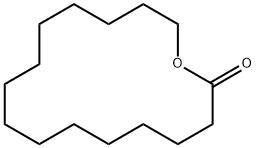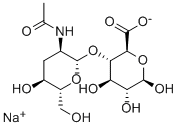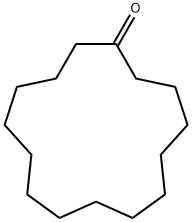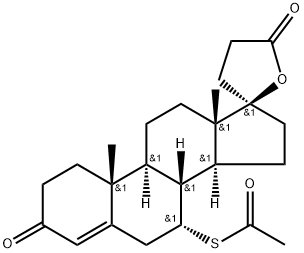Cyclopentadecanolide
Synonym(s):15-Hydroxypentadecanoic acid lactone;15-Pentadecanolide;1-Oxa-2-cyclohexadecanone;Pentadecanolide;Pentalide
- CAS NO.:106-02-5
- Empirical Formula: C15H28O2
- Molecular Weight: 240.38
- MDL number: MFCD00039667
- EINECS: 203-354-6
- SAFETY DATA SHEET (SDS)
- Update Date: 2024-11-19 23:02:33

What is Cyclopentadecanolide?
Chemical properties
Cyclopentadecanolide is a white crystalline low melting solid. melting at 36-37℃. to a colorless, viscous oil. B.P. 280℃. Delicately animal, musky and sweet, extremely tenacious odor of outstanding uniformity. Common use level in the perfume oil is about 0.1 to 0.4%.
Chemical properties
Cyclopentadecanolide occurs in small quantities in, for example, angelica root oil. It forms colorless crystals (mp 37–38°C) with a delicate, musk-like odor.
Chemical properties
ω-Pentadecalactone has an extraordinarily persistent, musk-like odor.
Occurrence
Originally reported found in the essential oil from angelica roots.
The Uses of Cyclopentadecanolide
As a fixative in perfumery.
The Uses of Cyclopentadecanolide
Pentadecanolide is a monomer used to make PGA-co-pentadecalactone polymers to be used in the development of directly compressed prolonged release tablets of slightly soluble drugs such as ketoprofen.
The Uses of Cyclopentadecanolide
Pentadecanolide may be used for the synthesis of poly(pentadecanolide) (PPDL) by Novozyme 435 catalyzed ring-opening polymerization. It may be employed as starting reagent for the synthesis of terminally-branched iso-fatty acids (iso-C15-C17).
What are the applications of Application
Pentadecanolide is a monomer used to make PGA-co-pentadecalactone polymers
Preparation
The main industrial syntheses start from compounds produced from cyclododecatriene: either by ring expansion of cyclododecanone or by depolymerization of polyesters of 15-hydroxypentadecanoic acid (from 1,12-dodecanediol).
Definition
ChEBI: Cyclopentadecanolide is a macrolide.
What are the applications of Application
Cyclopentadecanolide gives highly interesting effects when applied to certain flavors, e. g. alcoholic beverages, dentifrice flavors etc. There is very often a unanimous preference for the flavor that is properly treated with the hctone. Concentration in such flavors may be about 0.02 to 1.50 ppm calculated upon the finished consumer product. However, it should be kept in mind, that dentifrices are flavored at extremely high concentration (about 100) and it may therefore ghe an underestimated evaluation of the power of this Lactone, The most frequent abuse of Cyclopentadecanolide is that of over-dosage. It is also used extensively in Berry flavors, Liquor, Wine, Brandy, Fruit, Nut, Vanilla copositions, etc.
Aroma threshold values
Detection: 1 to 4 ppb
Taste threshold values
Taste characteristics at 75 ppm: vanilla bean, powdery helioropine, creamy and licorice.
Synthesis Reference(s)
Tetrahedron Letters, 34, p. 6107, 1993 DOI: 10.1016/S0040-4039(00)61741-0
The Journal of Organic Chemistry, 50, p. 2394, 1985 DOI: 10.1021/jo00213a044
General Description
Pentadecanolide is one of the major components, isolated from the root of Angelica archangelica L., species. It is a synthetic musk, which exists as a widespread contaminant in the environment.
Flammability and Explosibility
Non flammable
Trade name
Macrolide® (Symrise), Exaltolide®, Exaltolide®Total (Firmenich), Pentalide (Soda Aromatic).
Purification Methods
It has been recrystallised from MeOH (4 parts) at -15o. [Hundieck
Properties of Cyclopentadecanolide
| Melting point: | 34-38 °C(lit.) |
| Boiling point: | 137 °C2 mm Hg(lit.) |
| Density | 0.918 g/mL at 25 °C(lit.) |
| vapor pressure | 0.085Pa at 25℃ |
| FEMA | 2840 | OMEGA-PENTADECALACTONE |
| refractive index | 1.4700 |
| Flash point: | >230 °F |
| storage temp. | Sealed in dry,Room Temperature |
| solubility | Chloroform, Ethyl Acetate, Methanol (Slightly) |
| form | Solid |
| color | White to Off-White Low Melting |
| Odor | at 10.00 % in dipropylene glycol. musk animal powdery natural fruity |
| Water Solubility | Soluble in alcohol, dipropylene glycol. Insoluble in water. |
| JECFA Number | 239 |
| Merck | 14,3910 |
| BRN | 143710 |
| CAS DataBase Reference | 106-02-5(CAS DataBase Reference) |
| NIST Chemistry Reference | Oxacyclohexadecan-2-one(106-02-5) |
| EPA Substance Registry System | Oxacyclohexadecan-2-one (106-02-5) |
Safety information for Cyclopentadecanolide
| Signal word | Warning |
| Pictogram(s) |
 Environment GHS09 |
| GHS Hazard Statements |
H410:Hazardous to the aquatic environment, long-term hazard |
| Precautionary Statement Codes |
P273:Avoid release to the environment. P391:Collect spillage. Hazardous to the aquatic environment P501:Dispose of contents/container to..… |
Computed Descriptors for Cyclopentadecanolide
New Products
4-AMINO-TETRAHYDRO-PYRAN-4-CARBOXYLIC ACID HCL 4-(Dimethylamino)tetrahydro-2H-pyran-4-carbonitrile 4-Aminotetrahydropyran-4-carbonitrile Hydrochloride (R)-3-Aminobutanenitrile Hydrochloride 3-((Dimethylamino)methyl)-5-methylhexan-2-one oxalate 1,4-Dioxa-8-azaspiro[4.5]decane 5-Bromo-2-nitropyridine Nimesulide BP Aceclofenac IP/BP/EP Diclofenac Sodium IP/BP/EP/USP Mefenamic Acid IP/BP/EP/USP Ornidazole IP Diclofenac Potassium THOMAIND PAPER PH 2.0 TO 4.5 1 BOX BUFFER CAPSULE PH 9.2 - 10 CAP SODIUM CHLORIDE 0.1N CVS ALLOXAN MONOHYDRATE 98% PLATINUM 0.5% ON 3 MM ALUMINA PELLETS (TYPE 73) LITHIUM AAS SOLUTION 2-Bromo-1-(bromomethyl)-3-chloro-5-nitrobenzene 2-Bromo-3-nitroaniline N-(3-Hydroxypropyl)-N-methylacetamide 3-Bromo-6-chloropyridazine 4-ethyl-3-nitrobenzoic acidRelated products of tetrahydrofuran








You may like
-
 15-Pentadecanolactone CAS 106-02-5View Details
15-Pentadecanolactone CAS 106-02-5View Details
106-02-5 -
 Pentadecanolide CAS 106-02-5View Details
Pentadecanolide CAS 106-02-5View Details
106-02-5 -
 1823368-42-8 98%View Details
1823368-42-8 98%View Details
1823368-42-8 -
 2-(3-(tert-butyl)phenoxy)-2-methylpropanoic acid 1307449-08-6 98%View Details
2-(3-(tert-butyl)phenoxy)-2-methylpropanoic acid 1307449-08-6 98%View Details
1307449-08-6 -
 Ethyl 3-(furan-2-yl)-3-hydroxypropanoate 25408-95-1 98%View Details
Ethyl 3-(furan-2-yl)-3-hydroxypropanoate 25408-95-1 98%View Details
25408-95-1 -
 2-Chloro-5-fluoro-1-methoxy-3-methylbenzene 98%View Details
2-Chloro-5-fluoro-1-methoxy-3-methylbenzene 98%View Details
1805639-70-6 -
 1784294-80-9 98%View Details
1784294-80-9 98%View Details
1784294-80-9 -
 Lithium ClavulanateView Details
Lithium ClavulanateView Details
61177-44-4